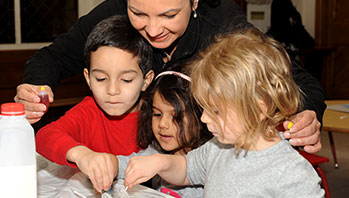- feathers
- rubber band guitars and any other class-made instruments from Discovery Time activities
- scarves
- tape or video recorder, toy instruments
- band
- music
- musical instrument
- musician
- pitch
- sound
- volume
MA Standards:
Language: L.PK.MA.6 Use words and phrases acquired through conversations, listening to books read aloud, activities, and play.
MA Draft STE Standards:
Physical Sciences/Matter and Its Interactions/Properties of Matter PS1.B Differentiate between the properties of an object and those of the material of which it is made in science explorations and activities such as art and music.
Physical Sciences/Energy PS4.B Apply their understanding in their play of how to change volume and pitch of some sounds.
Head Start Outcomes:
Logic and Reasoning/Reasoning and Problem Solving Recognizes cause and effect relationships.
Logic and Reasoning/Reasoning and Problem Solving Classifies, compares, and contrasts objects, events, and experiences.
PreK Learning Guidelines:
Science and Technology/Technology and Engineering 23 Explore and describe a wide variety of natural and man-made materials through sensory experiences.
Small Group: Making Group Music

© Commonwealth of Massachusetts, Department of Early Education and Care (Jennifer Waddell photographer). All rights reserved.
STEM Key Concepts: Sounds have a source; Sounds vary in three ways: by volume (loud or soft), pitch (high or low), and timbre (quality)
ELA Focus Skills: Speaking and Listening, Imaginative Play, Creative Expression
Have children continue to explore the musical instruments, music, and sounds that they will share at Music Day. Say, We will all be the musicians in a band tomorrow. Walk around the small groups to encourage them to try different volumes, pitches, and instruments in their pieces, and to work together to blend sounds.
Gather children and have each group perform their music. Ask, Have you ever played music or sang a song in front of a group of people before? How did you feel? Assure children that many people are often scared to perform music for other people and if they are really too scared to perform you can work out a way for them to be part of the performance without performing.
Adaptation: If you have older children, try a pattern circle. Have one child play a rhythm pattern with an instrument or their voice. Help the next child repeat the pattern. Continue around the circle as children add to the rhythm.
